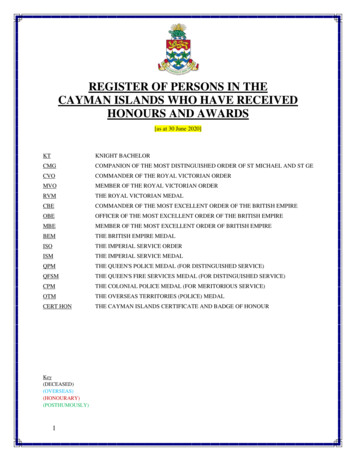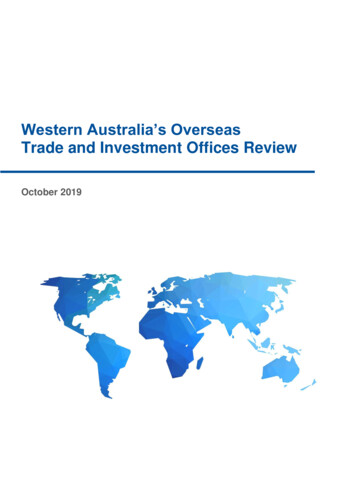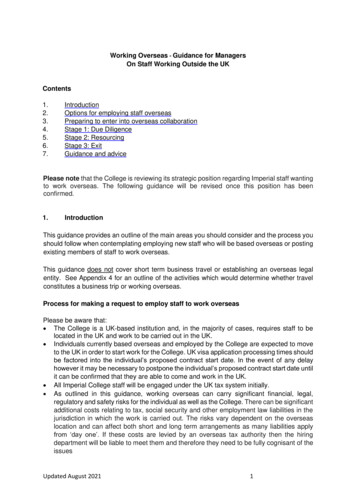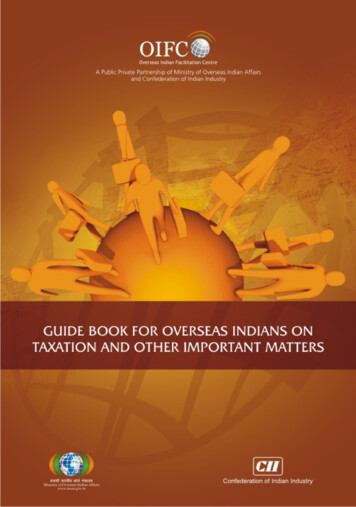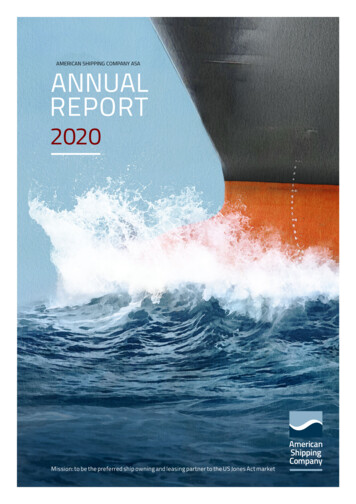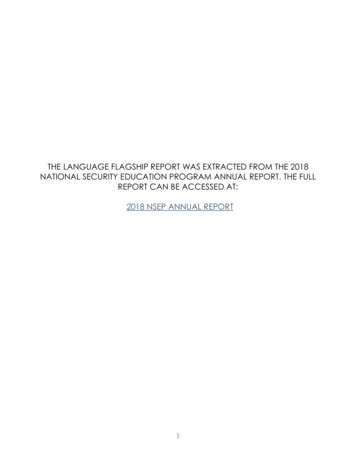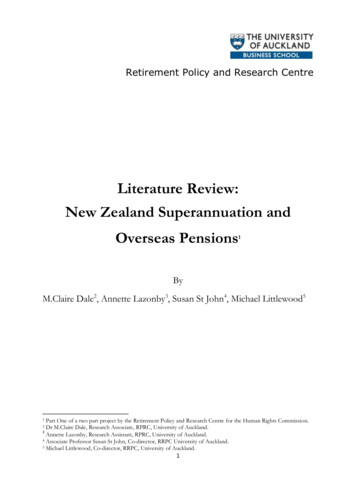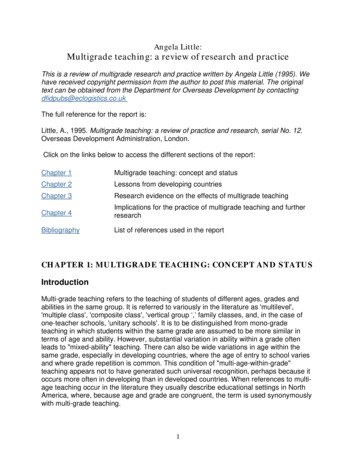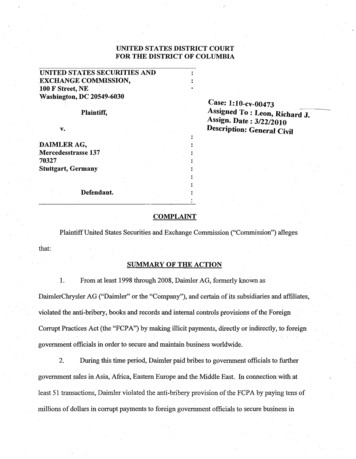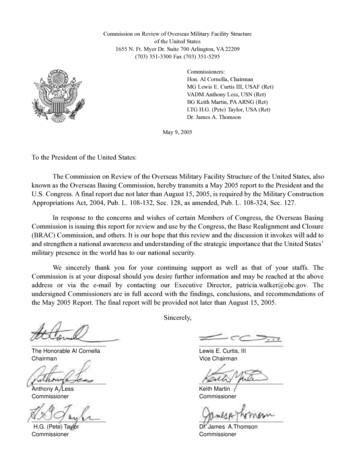
Transcription
Commission on Review of Overseas Military Facility Structureof the United States1655 N. Ft. Myer Dr. Suite 700 Arlington, VA 22209(703) 351-3300 Fax (703) 351-5295Commissioners:Hon. Al Cornella, ChairmanMG Lewis E. Curtis III, USAF (Ret)VADM Anthony Less, USN (Ret)BG Keith Martin, PA ARNG (Ret)LTG H.G. (Pete) Taylor, USA (Ret)Dr. James A. ThomsonMay 9, 2005To the President of the United States:The Commission on Review of the Overseas Military Facility Structure of the United States, alsoknown as the Overseas Basing Commission, hereby transmits a May 2005 report to the President and theU.S. Congress. A final report due not later than August 15, 2005, is required by the Military ConstructionAppropriations Act, 2004, Pub. L. 108-132, Sec. 128, as amended, Pub. L. 108-324, Sec. 127.In response to the concerns and wishes of certain Members of Congress, the Overseas BasingCommission is issuing this report for review and use by the Congress, the Base Realignment and Closure(BRAC) Commission, and others. It is our hope that this review and the discussion it invokes will add toand strengthen a national awareness and understanding of the strategic importance that the United States’military presence in the world has to our national security.We sincerely thank you for your continuing support as well as that of your staffs. TheCommission is at your disposal should you desire further information and may be reached at the aboveaddress or via the e-mail by contacting our Executive Director, patricia.walker@obc.gov. Theundersigned Commissioners are in full accord with the findings, conclusions, and recommendations ofthe May 2005 Report. The final report will be provided not later than August 15, 2005.Sincerely,The Honorable Al CornellaChairmanLewis E. Curtis, IIIVice ChairmanAnthony A. LessCommissionerKeith MartinCommissionerH.G. (Pete) TaylorCommissionerDr. James A.ThomsonCommissioner
Commission on Review of Overseas Military Facility Structureof the United States1655 N. Ft. Myer Dr. Suite 700 Arlington, VA 22209(703) 351-3300 Fax (703) 351-5295Commissioners:Hon. Al Cornella, ChairmanMG Lewis E. Curtis III, USAF (Ret)VADM Anthony Less, USN (Ret)BG Keith Martin, PA ARNG (Ret)LTG H.G. (Pete) Taylor, USA (Ret)Dr. James A. ThomsonMay 9, 2005To the Members of the United States Congress:The Commission on Review of the Overseas Military Facility Structure of the United States,also known as the Overseas Basing Commission, hereby transmits a May 2005 report to the Presidentand the U.S. Congress. A final report due not later than August 15, 2005, is required by the MilitaryConstruction Appropriations Act, 2004, Pub. L. 108-132, Sec. 128, as amended, Pub. L. 108-324, Sec.127.In response to the concerns and wishes of certain Members of Congress, the Overseas BasingCommission is issuing this report for review and use by the Congress, the Base Realignment andClosure (BRAC) Commission, and others. It is our hope that this review and the discussion it invokeswill add to and strengthen a national awareness and understanding of the strategic importance that theUnited States’ military presence in the world has to our national security.We sincerely thank you for your continuing support as well as that of your staffs. TheCommission is at your disposal should you desire further information and may be reached at the aboveaddress or via the e-mail by contacting our Executive Director, patricia.walker@obc.gov. Theundersigned Commissioners are in full accord with the findings, conclusions, and recommendations ofthe May 2005 Report. The final report will be provided not later than August 15, 2005.Sincerely,The Honorable Al CornellaChairmanLewis E. Curtis, IIIVice ChairmanAnthony A. LessCommissionerKeith MartinCommissionerH.G. (Pete) TaylorCommissionerDr. James A.ThomsonCommissioner
Executive SummaryINTRODUCTIONThe United States enters the new millennium as the foremost political, economic, andmilitary entity in the world. Seldom has history seen such a dominant, unilateral powerastride the international scene. Nonetheless, after what has proved to be only a briefinterlude of relatively unchallenged security in the wake of the collapse of the SovietUnion, we find ourselves in the midst of a global war on terror, armed conflict inAfghanistan and Iraq, and challenged by an international environment of potentiallyintense confrontation and hostility. Clearly we have rivals who resent our internationalpreeminence. Just as clearly, others will emerge in the future.SECURITY POSTUREWe have shifted our own security posture accordingly to counter the threat. We haveundertaken a transformation of strategy that is far-reaching in its implications on ourability to defend ourselves at home and to pursue our interests in the world. We haveformulated new doctrines, organized new unit structures, developed new weapons,communications, intelligence, logistics, and command and control systems, andsought new allies and altered basing locations at home and abroad. We are adoptingnew techniques and procedures, shifting our forces around the globe, and otherwiselaunching a myriad of innovations.Amidst this avalanche of change the Overseas Basing Commission was asked toassess the applicability and feasibility of the proposed global basing structure for U.S.forces. At the same time we were asked to look beyond just the single matter ofoverseas basing and to consider any other issues that impact on it and the overallsecurity of the United States. We offer our findings on both matters.The Commission was impressed by the many initiatives being taken by theDepartment of Defense (DOD), the Joint Chiefs of Staff, the individual services, andthe Combatant Commanders to adapt to a changing world. We were also struck by theenormity of the entire effort. The overseas basing structure as envisioned by theSecretary of Defense holds great potential for protecting and securing the nation, itsinterests and its allies in the post-9-11 world.The Commission fully understands the need for change and endorses much of what isplanned and already in progress. The movement of a heavy brigade out of Korea andthe shifting of forces remaining there south of the Han River, for example, makeeminently good sense. The expansion of cooperative security locations (CSL) andCOMMISSION ON REVIEW OF OVERSEAS MILITARY FACILITY STRUCTURE OF THE UNITED STATES
OVERSEAS BASI NG COMMISSIONforward operating sites (FOS)1 in key strategic locations around the globe adds tooperational flexibility, preserves a presence abroad, and serves to strengthen alliancerelationships. The transformation of military forces in the individual services intoexpeditionary capable units furthers our posture as a capabilities-based force. Theseand many of the other initiatives are positive developments which if done in fullcoordination with each other under a synchronized plan and within affordable costshold great promise for the future.On the other hand, the Commission expresses reservations on a number of rebasinginitiatives. For example, while we can see the wisdom of returning to the United Statesthe majority of Army heavy forces from Central Europe, we believe one heavy brigadeshould be kept in place for a variety of reasons that include demonstration of ourcommitment to the North Atlantic Treaty Organization (NATO), our resolve in Kosovoand elsewhere in the Balkans, and to hedge against future uncertainties regardingplanned rotational units in Eastern Europe.The Commission suggests that U.S. presence in Europe remains crucial to futureglobal stability. Nor are we sure that current discussions on relocating U.S. forces onOkinawa adequately address strategic concerns for U.S. security interests in East Asia.The Commission offers its views on these and other specific issues in the body of theReport.As the Commission did its work it found grounds for both praise and caution in regardto the Department of Defense (DOD) Integrated Global Presence and Basing Strategy(IGPBS). It notes that IGPBS itself was based largely on the Quadrennial DefenseReview (QDR) of 2001.2 That review was essentially completed prior to the attack onthe U.S. of September 11, 2001. Much additional change has transpired since thatevent. The 2005 QDR is now underway. Most likely it will generate more change.The Report that follows will detail in its several parts the geopolitical considerations,operational impacts, mobility concerns, quality of life implications, and cost burdens1 According to DOD, Forward Operating Sites (FOS) will be expandable “warm facilities” maintained with a limited U.S. military support presence and possibly prepositioned equipment. FOSswill support rotational rather than permanently stationed forces and be a focus for bilateral andregional training. Examples include: the Sembawang port facility in Singapore and Soto Cano AirBase in Honduras. Cooperative Security Locations (CSL) will be facilities with little or no permanent U.S. presence. Instead they will be maintained with periodic service, contractor, or host-nationsupport. CSLs will provide contingency access and be a focal point for security cooperation activities. A current example of a CSL is in Dakar, Senegal, where the Air Force has negotiated contingency landing, logistics, and fuel contracting arrangements, and which served as a staging area forthe 2003 peace support operation in Liberia.2 DOD Report to Congress, Strengthening U.S. Global Defense Posture, September 2004.ii
EXECUTIVE SUMMARYaffected by the amount of change underway. It is the combination of the concernsraised in each of these areas, however, which leads the Commission to its majorfinding that the timing and synchronization of the global rebasing initiatives must berethought.GEOPOLITICAL POSTUREThe U.S. overseas basing structure must serve both in the near term and for decadesto come. The global network of U.S. bases becomes the skeleton upon which the fleshand muscle of operational capability will be molded. The bases themselves and theagreements that govern them become both a reflection of and contributor to ouralliance relationships around the world.From a geopolitical perspective, implementation of each step of the process — thewithdrawal of units to the Continental United States (CONUS), the signing of a Statusof Forces Agreement (SOFA), access agreements and so on — creates a new globalposture. It is critical that the steps be taken in such a way that at any point in theprocess U.S. security is stronger, not weaker. Yet the withdrawals are front-loaded andcompensatory additions sometimes come only later.Moreover, the bases we select now cannot be oriented to dealing only with currentthreats. They must have the capacity to deal with threats that will emerge in decadesto come, and that consideration necessitates a more finite discussion of what the longterm threats might be. Even in a capabilities-based posture, we must have somerecognition of the range of threats we are likely to face, both near and long term. Atthe same time, we must consider the values of those with whom we are prepared toally.We diminish our presence in long-standing relationships with some concern that oncedeparted our ability to maintain influence is correspondingly reduced. We join intonew bilateral and multilateral relationships with some trepidation that if both ournational values and mutual interests do not converge a happy marriage will not result.The Commission notes that our base structure is not merely a derivative of strategy; itis a driver in its own right. It must, therefore, be fully integrated with every other facetof strategy before it can be properly affixed. It is the opinion of the Commission thata full dialogue by all necessary parties on the impact on U.S. security of the IntegratedGlobal Presence and Basing Strategy has not taken place.OPERATIONAL REQUIREMENTSOur military forces must be able to meet the force projection demands placed on themunder existing strategies and plans. Their training and equipment must be adequate toCOMMISSION ON REVIEW OF OVERSEAS MILITARY FACILITY STRUCTURE OF THE UNITED STATESiii
OVERSEAS BASING COMMISSIONthe task, access to key locations assured, and units and bases protected to the degreecommensurate with the risks we ask our service men and women to undertake. It isnot clear that all of these concerns have been addressed.Moreover, to launch major realignments of bases and unit configurations at a time weare in the midst of two major conflicts (Operation Enduring Freedom and OperationIraqi Freedom) takes us to the edge of our capabilities. Many of our active and reserveforces need to reset in light of the strain these operations have put on their equipmentand support systems. The intercontinental (in some cases) and intra-theater movementof operational units will impact force readiness for a period of time. Simultaneoustransformation of unit types and subsequent demands incurred by rotational cycleswill further stretch capabilities.All of these impacts must be taken into account if we are to maintain both ourcapability and flexibility throughout. The Commission finds no imperative for doingall of this in the short span of time now planned (2006 - 2011), and believes that if wecontinue at the current pace we are liable to handicap operational capability and runthe risk of creating new vulnerabilities.MOBILITYA central objective of a rebasing strategy is to ensure availability of requisite combatpower at the point of need. As we return forces from overseas, shift them within andbetween combatant commands, and transform them into more readily deployable unitswe seek an outcome of enhanced mobility.The Commission is concerned, however, that adequate strategic sealift, airlift, andprepositioned equipment and stocks do not exist and that current intra-theater airlift isover-stressed. Aside from the lift capability, the Commission is also concerned that theair and sea ports, inter-nodal connectivities and other mobility enabling systems arenot adequate to meet potential contingencies. Moreover, the Commission notes thatbudgetary plans for mobility assets are inadequate to meet projected lift demand.QUALITY OF LIFEThe nation relies on an armed force of committed volunteers. Throughout our history,they have served nobly in peace and war under sometimes rigorous conditions andwith varying degrees of risk. They have never failed us. The Commission notes all thathas been done to secure their well being and to look after their needs under the currentconditions of war and transformation. It is concerned, however, that unless somereordering of priorities takes place we are in danger of straining active and reserveforces and their families beyond the degree they should be asked to accept.iv
EXECUTIVE SUMMARYAs we reposition tens of thousands of family members to localities that may not havebeen given adequate time or budget to prepare for their proper reception, and as wesubject service members to repeated rotations abroad for extended periods of time(even in eras of unbroken peace), we may find ourselves unable to acquire therequisite numbers of recruits and reenlistments to maintain a viable volunteer force.The Commission believes that in the short run planners must take a “last day — firstday”3 approach to the movement of units and families from one location to another.Furthermore, the Commission suggests close monitoring of attitudes toward militaryservice in times of frequent and extended separations from home and family. Mostimportantly, the Commission recommends that quality of life considerations be apriority in the global realignment process.COSTSThe Department of Defense estimates the implementation of IGPBS to be between 9billion and 12 billion4 with only about 4 billion currently budgeted from fiscal years2006 through 2011.5 These costs may be understated. An independent analysisconducted for the Overseas Basing Commission put the tab at closer to 20 billion.6In some cases we will be moving into prime locations where available space andfacilities are scarce and for which we will pay top dollar (Okinawa and Singapore aretwo; there are several others). In other instances, we will be moving into key strategicpositions within or on the periphery of what is described in the Report (and elsewhere)as the “arc of instability” where accommodations are sparse and the surroundingregion depressed, but where nonetheless we could be asked to spend considerableamounts in return for our access (e.g., a 500 to 600 person steady-state presence inDjibouti could cost an additional 150 million).3 “Last day” refers to maintaining the support infrastructure for personnel at locations until the lastday they are in place. “First day” refers to having the support infrastructure in place on the first daytroops arrive at their new location.4 The 9 billion to 12 billion estimate includes base closure costs, the transportation costs to movepeople and equipment, any new facility costs at receiving locations, and the costs to establish FOSsand CSLs.5 Of the 4 billion, about 3 billion has been allocated to a Base Realignment and Closure accountthat has been established to pay for IGPBS actions related to BRAC, such as the cost connectedwith the movement of troops from overseas to U.S. installations. It does not include the KoreanLand Partnership Plan or Efficient Basing Grafenwoehr, as these projects were already funded. Inaddition, the projected funding estimate does not include host nation support dollars. Host nationsupport funding would defray some of the projected costs.6 The 20 billion estimate includes recurring life cycle costs, non-recurring overseas and domestic(for returning forces) estimated new facility costs. It also includes costs related to U.S. funding toimplement the Land Partnership Plan for Korea rebasing.COMMISSION ON REVIEW OF OVERSEAS MILITARY FACILITY STRUCTURE OF THE UNITED STATESv
OVERSEAS BASING COMMISSIONAdditionally, the costs associated with rebasing forces within CONUS have not beenfully analyzed. Over and above overseas relocation costs will be bills for servicetransformation, purchase of strategic and intra-theater lift, resetting of units and theirequipment sets in the active and reserve forces, replacement and expansion of stocks,new weapons and systems purchases, and continued force modernization. The sumtotal is enormous.Moreover, many of the costs are unprogrammed and will be drawn from individualservice operating budgets planned for other uses. We are in danger of robbing fromoperations and maintenance accounts to meet even minimal levels of construction andquality of life concerns. The Commission gives a strong caution that globalrestructuring and transformation ambitions may be bigger than our wallet.TIMING AND SYNCHRONIZATIONThe Commission fully understands the need for transformation and lauds the insightand vision behind the many different initiatives going forward. At the same time itexpresses a concern that the timing of several of the actions may be misguided and thatthe overall synchronization of the many separate undertakings is lacking. It is difficultto understand, for example, why we would withdraw all of our heavy forces fromEurope to replace them with a Stryker brigade before we have successfully developedan organic tank killing weapon system able to compete on the move with enemyarmor.Further, the Commission questions why we would move tens of thousands of servicemembers and their families to locations in the United States before we haveprogrammed the budgetary outlays to accommodate their arrival and before localcommunities are able to prepare services for population expansion. Nor can weunderstand why we must shift so rapidly to an expeditionary posture when we haveneither achieved the technological breakthroughs nor put budgetary programs in placeto produce the necessary fast sea lift to get displaced forces into action in accordancewith existing strategies and plans.These and other examples gave repeated indication that in far too many instances weare putting the cart before the horse. It is our observation that the detailedsynchronization required of so massive a realignment is lacking. The Commissionstrongly recommends that the pace of events be slowed and reordered.A BROADER PERSPECTIVEThe Commission began its work focused on the details of rebasing abroad. It soonbecame clear, however, that the overseas basing structure could not be viewed invi
EXECUTIVE SUMMARYisolation from all the other transformation activities and their cumulative effect on thesecurity of the United States.The information we gathered, visits we made, and hearings we held impressed uponus a number of things, among which were the commitment of our service membersand their military and civilian leaders, the need for change, and the dedication of theCombatant Commanders, individual services, and the Department of Defense to amore secure America. The Commission’s investigation and analysis, however, broughtit to a number of other conclusions as well.We found that the quest for greater security would benefit from the addition of thefollowing three critical elements.First, the nation would prosper from a more inclusive national discussion on how bestto arrange for the greater security of the United States. The Commission notes that thelast great transformation of America’s security posture in the world — the post-WorldWar II era that led up to and followed the 1947 National Security Act — was drivenby a process that brought together the best minds the country had to offer, the energiesof a collection of federal agencies and organizations, and the deliberations of a focusedand bipartisan legislature.The current transformation which has been ongoing since the end of the Cold War —massive in scope and in expected outcomes — has not had the benefit of such a widespectrum of views. It has been too much the purview of a single agency — theDepartment of Defense. The Commission recommends a larger involvement by all ofthe relevant organs of government informed by wide reflection from the best minds inpublic and private life.Second, the many events already undertaken and further changes that most likely willbe generated by the 2005 QDR require an overall architectural design. TheCommission repeatedly discovered disconnects between one event and another. Whileindividual efforts and separate commands were impressive in the scope andthoroughness, they often appeared to be inadequately linked to one another. No singleentity revealed itself as master of the entire plan. The Commission strongly suggeststhat the entire effort of transformation be tied together in one overarching design, andthat a specific body be assigned responsibilities to both guide and monitor itsimplementation.Third, the Congress of the United States must provide active oversight to the process.Cost and budgetary inconsistencies alone indicate that the Congress needs to exerciseCOMMISSION ON REVIEW OF OVERSEAS MILITARY FACILITY STRUCTURE OF THE UNITED STATESvii
OVERSEAS BASING COMMISSIONits full authority in ensuring that plans and programs are adequate to the task. Thisview is reinforced by the disconnection between the overseas basing plan and the baserealignment and closure process.The two are inherently related, yet the Congress is divorced from direct oversight fromeither, the latter by design and the former by a lack of information available to theLegislature on the effects of the entire process. The Commission recommends that theCongress exercise its oversight responsibilities fully and vigorously. It is time to adaptour security systems to meet emerging threats, and to do so by continuing a shift to acapabilities-based posture that will allow us to answer the range of challenges we face.But we cannot do so without an overarching plan.The Commission believes that change is necessary, but guided change that considersthe entirety of the security components of the United States, not just those related tothe Department of Defense. The Commission found that the overseas basing structurecannot be viewed in isolation from a myriad of other security-related considerations.Its feasibility and effectiveness can only be evaluated in context with all other aspectsof national security mentioned elsewhere in this Report. We believe that at some timetoo much activity in too short a time threatens to change transformation intoturbulence. We have concluded that we are doing too much too fast and a reorderingof the steps is necessary. We call, therefore, for a process of deliberation and reviewto accompany the zeal and aggressiveness to act.viii
Table of ContentsINTRODUCTIONMain Discussion:Introduction .1I. Geopolitical Considerations: .4The Threat .6Allies, Partners and Friends .8Integration and Timing of Strategic Constructs .11II. Operational Requirements .12Power Projection.13Force Protection .14Training and Exercises and Facilities.15Rotational Base .17III. Mobility.18Strategic Lift.18Intra-Theater Lift .20Prepositioning.21IV. Quality of Life .22Family Considerations .23Force Issues .24Recruitment and Retention.25V. Costs.26Overseas Basing .27Base Realignment and Closure.28Return of Forces Abroad .29Strategic Lift.30VI. Timing and Synchronization .31BRAC Implementation .31Actions by Other Nations.32Army Transformation and Modularization .32COMMISSION ON REVIEW OF OVERSEAS MILITARY FACILITY STRUCTURE OF THE UNITED STATESix
OVERSEAS BASING COMMISSIONResetting the Forces.33Continuing Operations.33Conclusions and Recommendations.C&R1Appendix A. Legislative Requirements.A1Appendix B. Commissioner Biographies .B1Appendix C. Acknowledgments.C1Appendix D. Study Methodology .D1Appendix E. Hearings and Visits .E1Appendix F. EUCOM Regional Assessment.F1Appendix G. CENTCOM Regional Assessment .G1Appendix H. PACOM Regional Assessment .H1Appendix I. SOUTHCOM Regional Assessment.I1Appendix J. Supporting Analysis for Operational Assessments .J1Appendix K. Timing and Synchronization.K1Appendix L. Deployment and Mobility.L1Appendix M. Total Costs .M1Appendix N. Quality of Life .N1Appendix O. Facility and Training Range Assessment.O1Appendix P. Recruitment and Retention.P1Glossary of Terms and List of Acronyms .GLO1References.REF1x
Main DiscussionINTRODUCTIONThe Commission on the Review of Overseas Military Facility Structure of the UnitedStates — more commonly known as The Overseas Basing Commission — wasestablished in 2003 by Public Law 108-132, as amen
The Commission on Review of the Overseas Military Facility Structure of the United States, also known as the Overseas Basing Commission, hereby transmits a May 2005 report to the President and the U.S. Congress. A final report due not later than August 15, 2005, is required by the Military Construction
